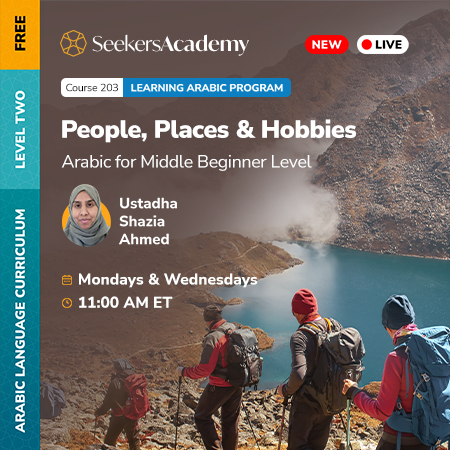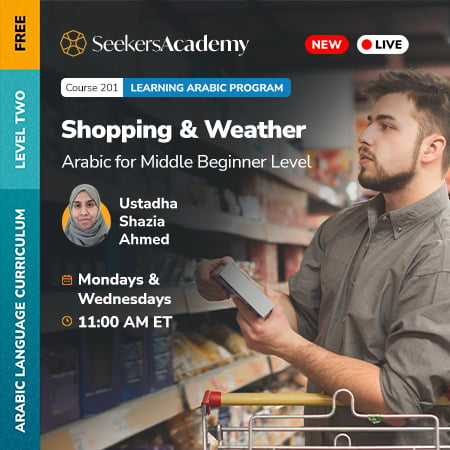
This sixth step in our Online Arabic learning program focuses on specific topics of everyday life. This 203 course is to be taken after completing Arabic 202. The 200 series includes intermediate courses within the beginner level.
The two chapters covered in this course are Chapter 11: People and places; and chapter 12: Hobbies. The student will learn vocabulary and dialogue particular to these topics while applying writing, reading, speaking and listening skills to the relevant vocabulary. The students will work on distinguishing between similar letter sounds and learn expressions and parts of Arabic culture that provide the means to converse with native speakers. The student will emerge from this class better acquainted with practical knowledge of Modern Standard Arabic.
One can take LC-301 after completing this course, the seventh step in our 27-course series of learning Arabic.
- Teacher: Ustadha Shazia Ahmad
Al-Arabiyya Bayna Yadayka (العربية بين يديك) is a famous textbook used worldwide for teaching Modern Standard Arabic to non-native speakers. It focuses on teaching culture, grammar and basic conversation, as well as touching on religion. Accompanied by sound files, it provides ample practice for each of the four skills of listening, reading, writing and speaking We are using the first of the eight volumes. This textbook is ideal for this curriculum because it contains the necessary parts for language fluency while being broken down into easy, manageable steps.
- This course is for non-native speakers, approximately ages 14 and above
- It is particularly beneficial for any students wanting to learn how to pick up Arabic speaking skills rapidly
- This is the third course in Level 2. To successfully complete this course, students should finish Arabic 202.
- This course can also be taken by anyone interested in grammar, improving their understanding of the Quran or solidifying their basic foundation of Arabic.
- Understand enough Arabic to move past a beginner level in communication.
- Speak about where one has lived, nationalities, the city and the village
- Know the feminine names of the colours.
- Distinguish between similar letters and sounds.
- Discuss hobbies and exhibitions
- Communicate fluently about people, places and hobbies.

This fourth step in our Online Arabic learning program focuses on specific topics of everyday life. This 201 course is to be taken after completing Arabic 103. The 200 series is the intermediate course within the beginner level.
The two chapters covered in this course are chapters 7 & 8, Study and Work. The student will learn vocabulary and dialogue particular to these topics, while apply writing, reading, speaking and listening skills to the relevant vocabulary. The students will work on distinguishing between similar letter sounds and learn expressions, and parts of Arabic culture that provide the means to converse with native speakers. The student will emerge from this class better acquainted with practical knowledge of Modern Standard Arabic.
- Teacher: Ustadha Shazia Ahmad
Al-Arabiyya Bayna Yadayka (العربية بين يديك) is a famous textbook used all over the world for teaching Modern Standard Arabic to non-native speakers. It focuses on teaching culture, grammar and basic conversation, as well as touching on religion. Accompanied with sound files, it provides ample practice for each of the four skills of listening, reading, writing and speaking We are using the first of the eight volumes. This textbook is ideal for this curriculum because it contains the necessary parts for language fluency while being broken down into easy, manageable steps.
- This course is for non-native speakers, approximately ages 14 and above.
- It is particularly beneficial for any students wanting to learn how to pick up Arabic speaking skills rapidly.
- This is the first course in Level 2. In order to successfully complete this course, students should finish Arabic 103.
- This course can also be taken by anyone who is interested in grammar, improving their understanding of the Quran or solidifying their basic foundation of Arabic.
- Understand enough Arabic to move past a beginner level in communication.
- Tell the time in Arabic (hours).
- Know the days of the week and months in Arabic.
- Distinguish between similar letters and sounds.
- Use more descriptive vocabulary regarding study and occupations in the Arab world.
- Formulate simple questions and answers regarding study and work.

This fifth step in our Online Arabic learning program focuses on specific topics of everyday life. This 202 course is to be taken after completing Arabic 201. The 200 series is the intermediate course within the beginner level.
The two chapters covered in this course are chapters 9 & 10, Shopping and Weather. The student will learn vocabulary and dialogue particular to these topics, while applying writing, reading, speaking and listening skills to the relevant vocabulary. The students will work on distinguishing between similar letter sounds and learn expressions and parts of Arabic culture that provide the means to converse with native speakers. The student will emerge from this class better acquainted with practical knowledge of Modern Standard Arabic.
One can take LC-203 after completion of this course, the sixth step in our 27-course series of learning Arabic.
- Teacher: Ustadha Shazia Ahmad
Al-Arabiyya Bayna Yadayka (العربية بين يديك) is a famous textbook used all over the world for teaching Modern Standard Arabic to non-native speakers. It focuses on teaching culture, grammar and basic conversation, as well as touching on religion. Accompanied by sound files, it provides ample practice for each of the four skills of listening, reading, writing and speaking We are using the first of the eight volumes. This textbook is ideal for this curriculum because it contains the necessary parts for language fluency while being broken down into easy, manageable steps.
- This course is for non-native speakers, approximately ages 14 and above.
- It is particularly beneficial for any students wanting to learn how to pick up Arabic speaking skills rapidly.
- This is the second course in Level 2. In order to successfully complete this course, students should finish Arabic 201.
- This course can also be taken by anyone interested in grammar, improving their understanding of the Quran or solidifying their basic foundation of Arabic.
- Understand enough Arabic to move past a beginner level in communication.
- Shop for student supplies, basic groceries, and clothing.
- Know the names of the colours.
- Distinguish between similar letters and sounds.
- Speak about the types of weather.
- Communicate fluently about shopping and the weather.